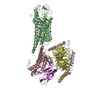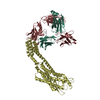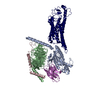+ Open data
Open data
- Basic information
Basic information
| Entry | Database: PDB / ID: 8jhc | ||||||
|---|---|---|---|---|---|---|---|
| Title | FZD3 in inactive state | ||||||
 Components Components |
| ||||||
 Keywords Keywords |  MEMBRANE PROTEIN / FZD3 / MEMBRANE PROTEIN / FZD3 /  complex. complex. | ||||||
| Function / homology |  Function and homology information Function and homology informationdopaminergic neuron axon guidance / serotonergic neuron axon guidance /  cell proliferation in midbrain / establishment of planar polarity / negative regulation of mitotic cell cycle, embryonic / midbrain morphogenesis / cell proliferation in midbrain / establishment of planar polarity / negative regulation of mitotic cell cycle, embryonic / midbrain morphogenesis /  Wnt receptor activity / non-canonical Wnt signaling pathway / motor neuron migration / sympathetic ganglion development ...dopaminergic neuron axon guidance / serotonergic neuron axon guidance / Wnt receptor activity / non-canonical Wnt signaling pathway / motor neuron migration / sympathetic ganglion development ...dopaminergic neuron axon guidance / serotonergic neuron axon guidance /  cell proliferation in midbrain / establishment of planar polarity / negative regulation of mitotic cell cycle, embryonic / midbrain morphogenesis / cell proliferation in midbrain / establishment of planar polarity / negative regulation of mitotic cell cycle, embryonic / midbrain morphogenesis /  Wnt receptor activity / non-canonical Wnt signaling pathway / motor neuron migration / sympathetic ganglion development / filopodium tip / Wnt-protein binding / post-anal tail morphogenesis / negative regulation of execution phase of apoptosis / commissural neuron axon guidance / PCP/CE pathway / Class B/2 (Secretin family receptors) / Wnt receptor activity / non-canonical Wnt signaling pathway / motor neuron migration / sympathetic ganglion development / filopodium tip / Wnt-protein binding / post-anal tail morphogenesis / negative regulation of execution phase of apoptosis / commissural neuron axon guidance / PCP/CE pathway / Class B/2 (Secretin family receptors) /  Wnt signaling pathway, planar cell polarity pathway / inner ear morphogenesis / positive regulation of neuroblast proliferation / presynaptic active zone / lateral plasma membrane / hair follicle development / canonical Wnt signaling pathway / response to electrical stimulus / Asymmetric localization of PCP proteins / neural tube closure / Wnt signaling pathway, planar cell polarity pathway / inner ear morphogenesis / positive regulation of neuroblast proliferation / presynaptic active zone / lateral plasma membrane / hair follicle development / canonical Wnt signaling pathway / response to electrical stimulus / Asymmetric localization of PCP proteins / neural tube closure /  electron transport chain / G protein-coupled receptor activity / electron transport chain / G protein-coupled receptor activity /  PDZ domain binding / neuron differentiation / Ca2+ pathway / PDZ domain binding / neuron differentiation / Ca2+ pathway /  periplasmic space / periplasmic space /  electron transfer activity / response to xenobiotic stimulus / iron ion binding / apical plasma membrane / electron transfer activity / response to xenobiotic stimulus / iron ion binding / apical plasma membrane /  axon / neuronal cell body / axon / neuronal cell body /  dendrite / dendrite /  heme binding / heme binding /  cell surface / cell surface /  plasma membrane / plasma membrane /  cytoplasm cytoplasmSimilarity search - Function | ||||||
| Biological species |   Homo sapiens (human) Homo sapiens (human)  Escherichia coli (E. coli) Escherichia coli (E. coli)synthetic construct (others) | ||||||
| Method |  ELECTRON MICROSCOPY / ELECTRON MICROSCOPY /  single particle reconstruction / single particle reconstruction /  cryo EM / Resolution: 3.3 Å cryo EM / Resolution: 3.3 Å | ||||||
 Authors Authors | Xu, F. / Zhang, Z. | ||||||
| Funding support | 1items
| ||||||
 Citation Citation |  Journal: Cell Discov / Year: 2024 Journal: Cell Discov / Year: 2024Title: A framework for Frizzled-G protein coupling and implications to the PCP signaling pathways. Authors: Zhibin Zhang / Xi Lin / Ling Wei / Yiran Wu / Lu Xu / Lijie Wu / Xiaohu Wei / Suwen Zhao / Xiangjia Zhu / Fei Xu /  Abstract: The ten Frizzled receptors (FZDs) are essential in Wnt signaling and play important roles in embryonic development and tumorigenesis. Among these, FZD6 is closely associated with lens development. ...The ten Frizzled receptors (FZDs) are essential in Wnt signaling and play important roles in embryonic development and tumorigenesis. Among these, FZD6 is closely associated with lens development. Understanding FZD activation mechanism is key to unlock these emerging targets. Here we present the cryo-EM structures of FZD6 and FZD3 which are known to relay non-canonical planar cell polarity (PCP) signaling pathways as well as FZD1 in their G protein-coupled states and in the apo inactive states, respectively. Comparison of the three inactive/active pairs unveiled a shared activation framework among all ten FZDs. Mutagenesis along with imaging and functional analysis on the human lens epithelial tissues suggested potential crosstalk between the G-protein coupling of FZD6 and the PCP signaling pathways. Together, this study provides an integrated understanding of FZD structure and function, and lays the foundation for developing therapeutic modulators to activate or inhibit FZD signaling for a range of disorders including cancers and cataracts. | ||||||
| History |
|
- Structure visualization
Structure visualization
| Structure viewer | Molecule:  Molmil Molmil Jmol/JSmol Jmol/JSmol |
|---|
- Downloads & links
Downloads & links
- Download
Download
| PDBx/mmCIF format |  8jhc.cif.gz 8jhc.cif.gz | 207.5 KB | Display |  PDBx/mmCIF format PDBx/mmCIF format |
|---|---|---|---|---|
| PDB format |  pdb8jhc.ent.gz pdb8jhc.ent.gz | 157.7 KB | Display |  PDB format PDB format |
| PDBx/mmJSON format |  8jhc.json.gz 8jhc.json.gz | Tree view |  PDBx/mmJSON format PDBx/mmJSON format | |
| Others |  Other downloads Other downloads |
-Validation report
| Arichive directory |  https://data.pdbj.org/pub/pdb/validation_reports/jh/8jhc https://data.pdbj.org/pub/pdb/validation_reports/jh/8jhc ftp://data.pdbj.org/pub/pdb/validation_reports/jh/8jhc ftp://data.pdbj.org/pub/pdb/validation_reports/jh/8jhc | HTTPS FTP |
|---|
-Related structure data
| Related structure data |  36262MC  8j9nC  8j9oC  8jh7C  8jhbC  8jhiC M: map data used to model this data C: citing same article ( |
|---|---|
| Similar structure data | Similarity search - Function & homology  F&H Search F&H Search |
- Links
Links
- Assembly
Assembly
| Deposited unit | 
|
|---|---|
| 1 |
|
- Components
Components
| #1: Protein | Mass: 74095.141 Da / Num. of mol.: 1 Source method: isolated from a genetically manipulated source Details: inactive FZD3 Source: (gene. exp.)   Homo sapiens (human), (gene. exp.) Homo sapiens (human), (gene. exp.)   Escherichia coli (E. coli) Escherichia coli (E. coli)Cell line (production host): Sf9 / Production host:   Spodoptera frugiperda (fall armyworm) / References: UniProt: Q9NPG1, UniProt: P0ABE7 Spodoptera frugiperda (fall armyworm) / References: UniProt: Q9NPG1, UniProt: P0ABE7 |
|---|---|
| #2: Antibody | Mass: 25704.648 Da / Num. of mol.: 1 Source method: isolated from a genetically manipulated source Source: (gene. exp.)   Homo sapiens (human) / Cell line (production host): Hi5 / Production host: Homo sapiens (human) / Cell line (production host): Hi5 / Production host:   Trichoplusia ni (cabbage looper) Trichoplusia ni (cabbage looper) |
| #3: Antibody | Mass: 14927.301 Da / Num. of mol.: 1 Source method: isolated from a genetically manipulated source Source: (gene. exp.) synthetic construct (others) / Production host:   Escherichia coli (E. coli) Escherichia coli (E. coli) |
| #4: Antibody | Mass: 23209.820 Da / Num. of mol.: 1 Source method: isolated from a genetically manipulated source Source: (gene. exp.)   Homo sapiens (human) / Cell line (production host): Hi5 / Production host: Homo sapiens (human) / Cell line (production host): Hi5 / Production host:   Trichoplusia ni (cabbage looper) Trichoplusia ni (cabbage looper) |
-Experimental details
-Experiment
| Experiment | Method:  ELECTRON MICROSCOPY ELECTRON MICROSCOPY |
|---|---|
| EM experiment | Aggregation state: PARTICLE / 3D reconstruction method:  single particle reconstruction single particle reconstruction |
- Sample preparation
Sample preparation
| Component | Name: complex of FZD3 with anti-Bril Fab and anti-Fab Nanobody Type: COMPLEX / Entity ID: all / Source: MULTIPLE SOURCES | ||||||||||||||||
|---|---|---|---|---|---|---|---|---|---|---|---|---|---|---|---|---|---|
| Source (natural) |
| ||||||||||||||||
| Source (recombinant) |
| ||||||||||||||||
| Buffer solution | pH: 7.4 | ||||||||||||||||
| Specimen | Embedding applied: NO / Shadowing applied: NO / Staining applied : NO / Vitrification applied : NO / Vitrification applied : YES : YES | ||||||||||||||||
Vitrification | Cryogen name: ETHANE |
- Electron microscopy imaging
Electron microscopy imaging
| Experimental equipment |  Model: Titan Krios / Image courtesy: FEI Company |
|---|---|
| Microscopy | Model: FEI TITAN KRIOS |
| Electron gun | Electron source : :  FIELD EMISSION GUN / Accelerating voltage: 300 kV / Illumination mode: OTHER FIELD EMISSION GUN / Accelerating voltage: 300 kV / Illumination mode: OTHER |
| Electron lens | Mode: DIFFRACTION / Nominal defocus max: 2200 nm / Nominal defocus min: 1200 nm / Nominal defocus max: 2200 nm / Nominal defocus min: 1200 nm |
| Image recording | Electron dose: 20 e/Å2 / Film or detector model: GATAN K3 (6k x 4k) |
- Processing
Processing
CTF correction | Type: PHASE FLIPPING AND AMPLITUDE CORRECTION | ||||||||||||||||||||||||
|---|---|---|---|---|---|---|---|---|---|---|---|---|---|---|---|---|---|---|---|---|---|---|---|---|---|
3D reconstruction | Resolution: 3.3 Å / Resolution method: FSC 0.143 CUT-OFF / Num. of particles: 221700 / Symmetry type: POINT | ||||||||||||||||||||||||
| Refine LS restraints |
|
 Movie
Movie Controller
Controller








 PDBj
PDBj











